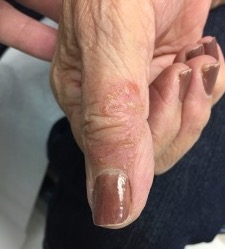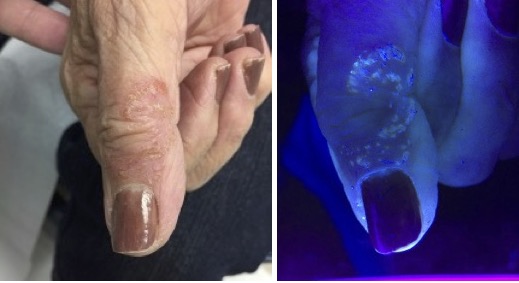A 74-year-old woman treated for presumed impetigo on the thumb did not respond initially to a course of clindamycin nor treatment 8 days later with doxycycline. What’s your diagnosis?
Honey-Crusted Erosion on Thumb
By Frank Hall Reynolds, MD
Chattanooga Skin and Care Clinic, Chattanooga, Tennessee
CASE HISTORY
A 74-year-old woman was being evaluated for abnormal moles when a honey-colored crusted erosion was noted on her right thumb (Figure 1).

She recalled having a manicure 3 weeks previously and being accidentally nicked in the proximal nail fold area. She was not immunocompromised but was a Type 2 diabetic.
Clindamycin was begun for presumed impetigo.
Eight days later, she was seen again without improvement and started on doxycycline. She also had a bacterial culture.
A week later, the skin had not improved.
What is your diagnosis?
DISCUSSION

The bacterial culture grew Pseudomonas fluorescens and Wood’s light exam revealed fluorescence (Figure 2). Ciprofloxacin 500 mg twice per day for 8 days was begun, along with soaks of white vinegar diluted in distilled water.
The lesion resolved, but ciprofloxacin was discontinued early due gastrointestinal side effects.
Three months later, the lesion recurred in the same location, and ciprofloxacin was administered again but response was incomplete.
When seen in the office, the lesion morphologically appeared the same and in the exact location as originally. Fluorescence was again present.
Levofloxacin 500 mg per day was begun with dilute white vinegar soaks. This resulted in 80% clearance, and it was decided to try topical tobramycin with gentian violet for the persistent area of infection with eventual complete resolution.
P. fluorescens is a Gram-negative bacteria found in soil, plants, and water. It is also a low-level inhabitant of the human microbiome. Although it is considered of low virulence and an uncommon cause of infection, cases of bacteremia have been reported. Fluorescence under UV light is imparted by the pigment pyoverdine (fluorescein). Interestingly, this bacterium naturally produces the antibiotic mupirocin.
References:
- Scales BS, Dickson RP, LiPuma JJ, et al. Microbiology, genomics, and clinical significance of the Pseudomonas fluorescens species complex, an unappreciated colonizer of humans. Clin Microbiol Rev. 2014 Oct;27(4):927-48. doi: 10.1128/CMR.00044-14. PMID: 25278578; PMCID: PMC4187640.
- Wong V, Levi K, Baddal B, et al. Spread of Pseudomonas fluorescens due to contaminated drinking water in a bone marrow transplant unit. J Clin Microbiol. 2011 Jun;49(6):2093-6. doi: 10.1128/JCM.02559-10. Epub 2011 Mar 30. PMID: 21450958; PMCID: PMC3122780.


